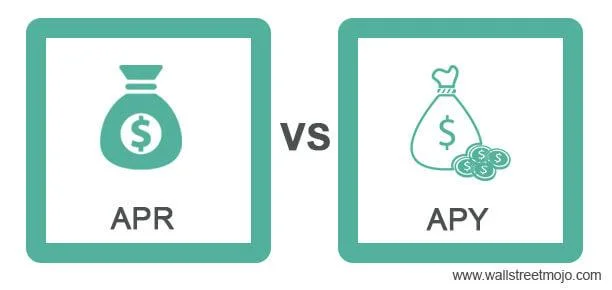The key difference between APR and APY in India is that APR is the annual percentage rate, which is the interest that is charged by a lender on a loan or credit card, while APY is the annual percentage yield, which is the annual return that is earned on a financial product like a savings or investment account. APR is expressed as a single percentage rate, while APY takes compounding interest into account and is expressed as a percentage rate with multiple decimal places.
Annual Percentage Rate (APR)
The annual percentage rate (APR) is the rate of interest charged on a loan or investment, expressed as an annual rate. It is the rate of interest charged on an annual basis, including fees and other costs associated with the loan.
Annual Percentage Yield (APY)
The annual percentage yield (APY) is the effective annual rate of return earned on an investment. It is the rate of return calculated by taking into account the effect of compounding interest. It also takes into account the effect of fees and other costs associated with the loan or investment.
The key difference between APR and APY is that the APR is the rate of interest charged on a loan or investment, expressed as an annual rate, while the APY is the effective annual rate of return earned on an investment, taking into account the effect of compounding interest.
Key factors to consider while taking different types of unsecured loans
The unsecured loan application process is quick and convenient, as individuals can now borrow money online and utilise funds for urgent requirements. However, since any collateral or security does not back these financing options, borrowers need to keep in mind specific pointers to ensure they get the best deal. These are discussed below:
Check interest rate and additional charges
One of the major factors to consider when opting for unsecured loans is interest rates. Borrowers must know that since unsecured financing is not backed by collateral or security, the financial institution charges a high-interest rate to safeguard the money lent out. In such cases, unsecured loan applicants must compare the interest rates offered by various lenders and settle for one that best suits them. Remember, there is no standard rate of interest in the market. Further, borrowers have to choose between floating and fixed interest rates, where a difference of a few digits or fractions can significantly impact the total cost of borrowing. This is important for all types of unsecured loans, such as car loans. Most car dealers have ties with various lenders. Hence, borrowers can easily collect quotations on interest rates and select the most beneficial deal. Further, applicants must check for additional charges like processing fees, foreclosure, and prepayment charges. Supposing an applicant has applied for a personal loan and wants to make a prepayment, reducing the total interest amount, they must be aware that the lenders can impose restrictions and charges for making prepayments. This is why borrowers must know company policies and be mindful of hidden costs before signing a personal loan agreement.
Know your credit score
A credit score is a crucial determinant of unsecured loan eligibility. A CIBIL, or credit score, is a three-digit number that ranges from 300 to 900, reflecting the creditworthiness of borrowers. It shows the financial stature of an applicant concerning their disposable income, outstanding obligations, borrowing and repayment patterns, and history. The higher the score, the better the chances of loan approval. Please note that loan terms (such as interest rate) and amount depend highly on the credit score. Here, if an applicant with a credit score of 750 or above applies for a personal loan, they have a higher chance of instant approval with improved terms than an applicant with a credit score of 630. The same applies to other types of unsecured loans, such as car loans or business loans. If individuals with high credit scores apply for such financing options, they can avail of loans at favourable servicing terms.
Asses EMI burden
Whether individuals apply for a business loan or personal loan (even if taken to finance a great education abroad), they must evaluate their needs and apply for the required amount. Assessing the borrower’s needs and ability to repay are keys to managing loans efficiently. Apart from the loan amount, individuals must judiciously decide on the loan tenor. Both the loan amount and the tenor play a significant role in determining the EMI amount. While a longer tenor helps individuals lower their EMI burden, a shorter tenor increases the same. The first option seems convenient for individuals who have taken personal loans for education purposes. Students usually apply for an education loan with a co-applicant and start to repay the loan after the stipulated study period and the additional year-end. Here, if they choose a longer tenor, they can repay without any worry even if they initially do not get a satisfactory job. However, one must note that a longer tenor also leads to a high-interest outgo at the end of the tenor, increasing the total cost of borrowing. To decide on an affordable EMI, keeping in mind the interest outgo, individuals can use online calculators to calculate personal loan EMIs by entering various tenor options.

